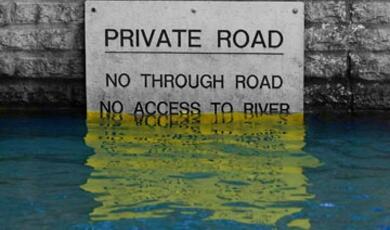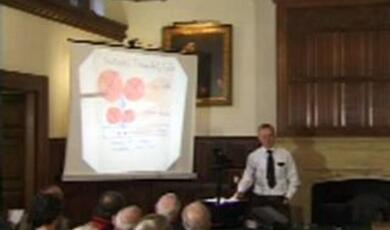How the Zebra Got its Stripes
Share
- Details
- Text
- Audio
- Downloads
- Extra Reading
In Rudyard Kipling's Just So story, the Leopard got its spots when the Ethiopian painted them on with his fingers. In the real world, the answer to the question of where patterns come from is not so simple. While the processes of natural selection provide us with a mechanism by which patterns such as spots or stripes might be retained from one generation to the next, the question of how the patterns are programmed is something of a mystery.
In this lecture, a series of ever more complex and spectacular chemical reactions will be used to show how very simple ideas in chemistry can lead directly to the idea of feedback, the crucial insight given by the mathematician Alan Turing, that provides a plausible mechanism that causes complex structures and patterns to emerge as if from nowhere.
[© Coleen Slater]
This the first in a series of three lectures on Patterns. The other lectures are as follows:
How mathematicians think about patterns by Professor Ian Stewart
God's Good Order and the Artist's Patterns by Professor Ben Quash
Download Text
16 January 2013
How the Zebra got its Stripes
Professor Andrea Sella
As a child you may have read Rudyard Kipling’s famous story “How the Leopard got its Spots”, a tale in which a man stipples the leopard’s fur using his fingers. While the story is for children, the question is a profound one, and one that has been asked by several generations of scientists, most famously by a man called D’Arcy Thompson in the late 19th century who wondered what scientific rules determined the shapes and patterns that we see in the animals and plants in our world. Could one use mathematics to describe the spirals in sunflowers, or the curve of a nautilus shell.
If you were asked this today, you might be tempted to answer that stripes are coded for by DNA. But is that really true? Everyone says that DNA is the blueprint that makes us what we are. But there’s a real problem with this idea. Each chunk of DNA is simply a code – a set of instructions telling a cell to make a specific protein. The DNA does not actually say put spots or stripes here. Or hair there. Or of this colour. So there is a gap between the molecular world of cells and how they develop, and the structures we see when we are talking about whole organisms. The process by which an organism develops from a single cell into something with organs, bones, muscles, fur, and so on is called morphogenesis. And it is one of the deepest and most difficult problems in all of science.
In order to bridge the gap and get some insights into morphogenesis we need to think a little bit about chemistry.
Everyone knows how chemical reactions go. You mix two things together and, as if by magic, a colour change occurs. If you are really lucky, the whole thing goes bang.
We can represent this sequence of events as follows:
A + B ®Products
Why would such a reaction happen? The fact that the reaction “goes” – in other words, that products are formed, tells us that the products are more stable than the reactants. One way of thinking about this is that the bonds in the product molecules are stronger than those in the starting materials, A and B. As chemists we use an everyday analogy and say that the reaction proceeds downhill. So in the same way as ball or skateboard will roll down a slope, the reaction goes from high energy to low energy without any outside assistance.
As chemists we can study these reactions and there are two things we are looking for. We want to know what the products are. But we also know how they are made – this is called the mechanism and it is the thing that is meant by the arrow. In the equation above the arrow is probably where the most interesting stuff is actually hidden.
Occasionally we come across a reaction that is different and that doesn’t “behave as it should”. The most famous of these are the oscillating reactions. These are reactions that change colour every few seconds, seemingly switching back and forth between two states. You might be tempted to imagine that the reaction can’t make up its mind – going to products and then going back again. Yet, our ball analogy tells us that that must be nonsense. Have you ever seen a ball or a skateboard roll down a hill and then change its mind and come back up again? That sounds like complete nonsense.
A better way to think of this is to imagine a skier coming down a mountain. Skiers don’t (usually!) throw themselves headlong down the mountain. Instead they make a long series of turns, twisting left and right as they descend. And this is very much what are oscillating reactions are like.
What we are seeing is the path on the way to equilibrium; the mechanism of the reaction is made visible. The colour changes simply reflect changes in the concentrations of intermediate molecules in the reaction.
How can one understand this process? One way is to imagine chemical reactions to be a bit like populations of animals. If the animals reproduce, then their number – the concentration – rises. But if there is a predator, they are eaten and their population falls.
Imagine the following scenario. We take two rabbits and put them in a field. They reproduce and produce more rabbits. This in turn leads to even more rabbits and the concentration rises. This is called autocatalysis – the reaction is, in a way, self-catalyzing. The more you have the more you get. This is an example of a positive feedback loop.
How can we control the rabbit population? We can introduce two foxes. They too will reproduce so their population will rise. But at the same time they eat rabbits. The two populations are now entwined and their destinies are inextricably linked. If the rabbit population rises, that allows the fox population to rise. But if the fox population rises then that inhibits the rabbits and their population falls.
So we have now introduced is a negative feedback that can counteract the autocatalysis – a kind of thermostat, if you will – which can help to control the populations.
So oscillating reactions are strange chemical reactions in which both positive and negative feedbacks occur giving us the stunning visual effects that we see in the flasks. And if you think about your heart, it beats rhythmically due to alternating contraction and relaxation of proteins, and the alternating flow and pumping of sodium, potassium and calcium ions. Our bodies are full of these oscillating systems, that lie quite literally at the heart of biology.
But what if we don’t stir our flask? That’s where it becomes even more interesting. Now the oscillations happen but we can’t predict where they will start. So the initial switch between the different states occur in a specific location and then trigger oscillation in the neighbouring solution. The result is that we start to see waves of colour coursing across the solution. The surprising thing is that the waves actually travel faster than the molecules in the solution. What can be going on here?
What we are seeing is the transfer of chemical information. In other words, when the reaction is triggered, a chemical signal is sent out, causing neighbouring regions to flip. They do a bit like a row of dominoes – the dominoes themselves don’t actually move very much, yet the signal can be seen to speed along across space. And all of this is driven by the feedback loops we discussed earlier.
If this seems a bit abstract then ask yourself how your brain finds out that you’ve just put your finger on something hot. It’s not because a signalling molecules has travelled all the way from finger to brain. That would be much too slow. What biology has developed are exquisitely optimized signalling systems which harness chemical feedbacks. These are called neurons and they consist of long cells with little pumps in them that move sodium and potassium around across the membrane of the cell. When the signal comes along pores open causing the sodium and potassium to flood across. This in turn leads to the next pore opening. The signal travels rapidly from finger up the arm to your brain. Ouch!
At the same time, the stripes and whorls that we see in these solutions are reminiscent of the stripes on the side of tiger or a zebra. Or the spots on a leopard. Could it be that similar processes are being used to cause cells to produce different coloured pigments? This is the hypothesis that was put forward by Alan Turing back in the 1950’s and the idea that patterns might be generated by a combination of reaction rates and diffusion is a profound one that has had a huge impact on scientists thinking about the structures and control in biological systems.
It is clear that these oscillating reactions give us profound insights into the mechanisms by which biology operates. And what is so clever is that the mechanisms by which these things happen operate at a very simple and level, not requiring fancy DNA coding. All you need are the right set of linked reactions and then away you go transmitting signals and making patterns. What you are exploiting is a kind of chemical intelligence and what it tells us is that patterns are deeply woven into the fabric of our world.
© Professor Andrea Sella 2013
This event was on Wed, 16 Jan 2013
Support Gresham
Gresham College has offered an outstanding education to the public free of charge for over 400 years. Today, Gresham College plays an important role in fostering a love of learning and a greater understanding of ourselves and the world around us. Your donation will help to widen our reach and to broaden our audience, allowing more people to benefit from a high-quality education from some of the brightest minds.


 Login
Login







